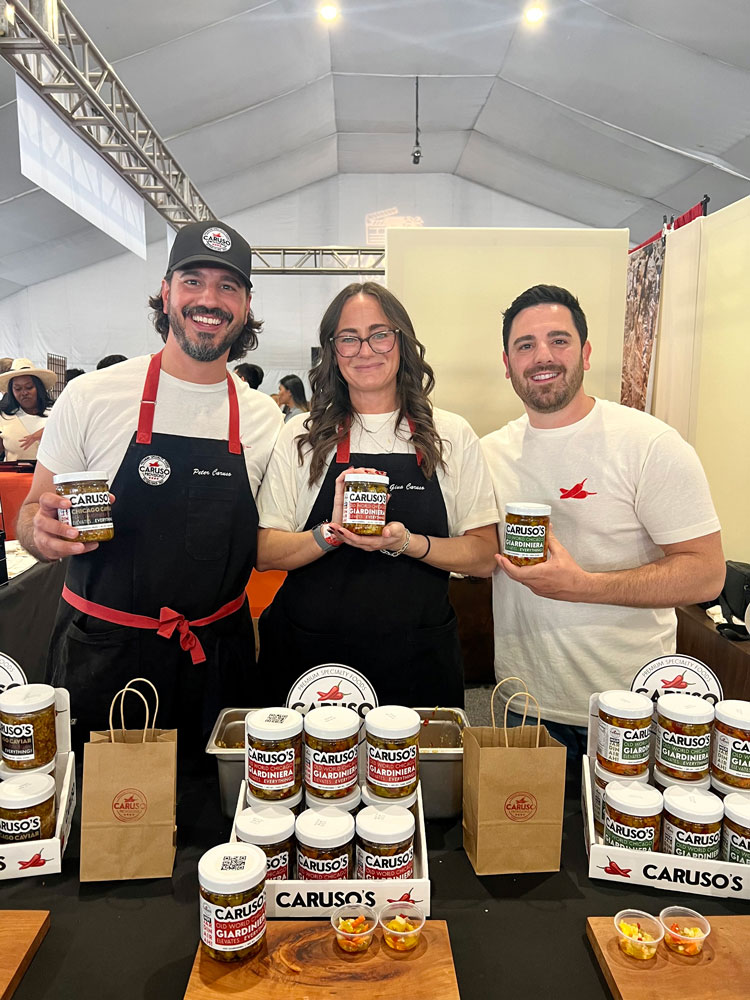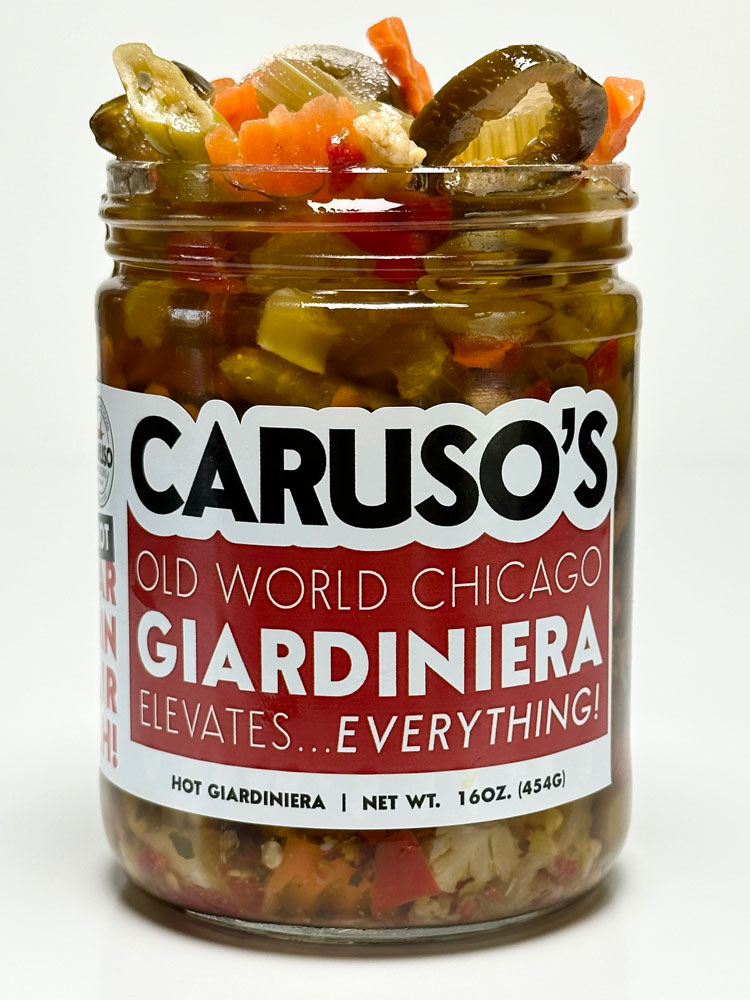
Last month, Chicago published a big, beautiful giardiniera feature that looked at our city’s favorite condiment from every angle. For my part, I conducted a blind taste test of the most popular brands available to consumers.
That test involved spooning hot giard over squares of tavern-cut pizza. Most were good, but there was one I had to spit out. I asked everyone in the room to try it, which they did to a chorus of “ewwws.” This jar was clearly off: the veggies were pale and the oil had a flavor like wet cardboard. I figured it was rancid.
To our surprise, this giardiniera was the pricey, small-batch artisanal product from Caruso Provisions. It was, without exception, the one that all the chefs we spoke with recommended. After the results came in, my editor Amy Cavanaugh asked me to pick up another jar to make sure it wasn’t a one-off. The second jar was also bad. Perhaps, though, I made a mistake in buying it from the same market, so I went on DoorDash and found the furthest market from my home that would deliver, which was in Norridge. Alas, this one was no better, so we went to print with a warning against Caruso.
Soon after the article and its accompanying video ran, I received a DM from a certain Peter Caruso. Uh oh. His message read in part, “Sorry to hear you got a bad jar… that definitely doesn’t reflect what we make. Out of everything we’ve sold, this is the first time we’ve heard feedback like that.” Caruso offered to meet and drop off a few jars from a batch just off the line. I agreed and suggested I bring the remainders of the jars I had purchased so that we could do a taste test.
When the day arrived, I met not one but two Carusos. Dominic Caruso, a trained chef who worked for New York’s Major Food Group, developed a line of products based on a recipe from their grandmother, Nancy Caruso. Yet it was Peter Caruso, who works in commercial real estate, who first got the idea for the business. At a deli in Florida in March 2021, he asked for some giardiniera to put on a sandwich. The guy behind the counter said, “What’s that?” The lightbulb went off, and by October of that year the first run of 2,000 jars came off the line at a local food packing facility.

The Carusos gave those early jars of hot and mild giardiniera away. One of their first clients was Angelo’s Stuffed Pizza in Archer Heights. They did some demos, and got in a few markets here and there. Tempesta Market soon tuned into their product — which, unlike most others, was packed in olive oil rather than neutral vegetable oil. A chef at Joe’s Seafood, Prime Steaks and Stone Crab introduced Caruso’s to his bosses at Lettuce Entertain You Enterprises, which became a client. Chef Rob Levitt at Publican Quality Meats became a fan just as a little TV show called The Bear got everyone interested in Italian beef sandwiches. Levitt got the idea to sell make-at-home beef kits, which included a jar of Caruso’s. A huge order came in, and the Carusos ramped up production.
Today Caruso Provisions giardiniera is in 2,000 restaurants as well as 1,000 stores in 30 states nationwide, thanks to a distribution agreement with Fresh Market. This growth is all the more astonishing considering that the core employees of the company are the five members of the Caruso family — Dominic and Peter, along with their sister Gina and parents Karen and Charles.
So what went wrong with the first jars I sampled?
I pulled my two jars of hot giardiniera out of a paper bag, handed the brothers plastic spoons and suggested they give it a try. Dominic spooned some onto the inverted lid and poked at it with a grave expression. “The peppers look really washed out,” he said. He took a taste and winced. “There’s excess water in it, and that will change the jar’s flavor,” he explained. The vegetables are first brined to both season them and regulate their moisture content and texture before they are packed with aromatics and seasonings in olive oil. Celery and peppers are both high-moisture vegetables, and sometimes they retain too much juice even after the brine. “You know, traditionally people made giardiniera once or twice a year,” he said, “but we’re constantly producing small batches throughout the year, so the vegetables are coming from different places.” Each of the three jars I had purchased came from the same misbegotten batch.
Peter pulled out three more jars of giardiniera — hot, mild, and “Chicago Caviar” relish. I could see right away that these jars looked different with brightly colored peppers and carrots. I dipped a spoon in and, wow: night and effing day. This giard was sweet and complex, with a first-press California olive oil base carrying all the distinctive vegetable and aromatic flavors. I wanted to keep spooning more.
We made the exchange: I took the good jars, and they took the bum ones to test and learn from. Peter Caruso said that despite the Italian beef craze The Bear unleashed, sales are still far stronger in Chicago than elsewhere. Perhaps that’s because here we know just how versatile this condiment can be.
“Sure it’s good on a beef,” Peter said, “but we’re trying to lead the way and show people around the country how it can work on everything else.”
Random Yums
Giant’s “Test Kitchen” list of daily specials — dishes that are a little more seasonal, a little more experimental, a little smaller and cheaper — is really something to keep your eye on, particularly if you like light, seasonal desserts. I loved a bowl of cherry sorbet with macerated strawberries from Mick Klug Farm. Lately they’ve featured raspberries with rhubarb granita.
Yoo Yee, a Sichuan restaurant just around the corner from the Asia on Argyle corridor in Uptown, has been getting a lot of attention for its hand-pulled noodles and dishes awash in the hot and numbing ma la flavors of red chile and Sichuan peppercorns. All good if you don’t mind their liberal use of salt, but the star dish for me is an appetizer of cold marinated eggplant topped with spicy green pepper relish. It’s one of those dishes that only gets better after the leftovers have had a day in the fridge.
You’ve heard of the cronut but what would you call a hybrid of buttery Danish dough and fluffy Japanese shokupan milk bread? Shokunish? Danpan? The good people at Pastry House Hippo inside Mitsuwa Marketplace in Arlington Heights just call their furled masterpiece Danish bread. Give it a light toast, slather even more butter on it to gild the lily, and swoon.



